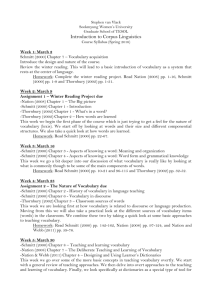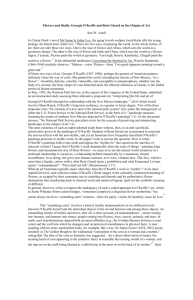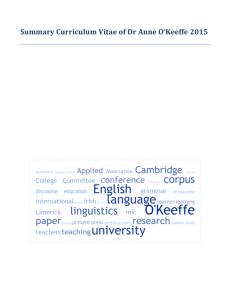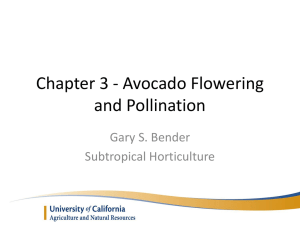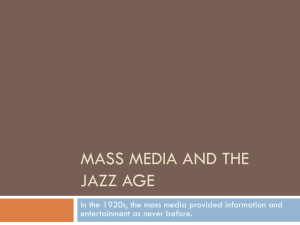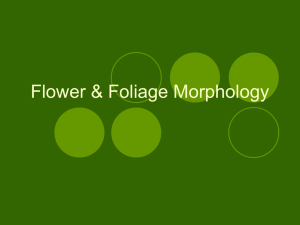GEORGIA O`KEEFFE
advertisement
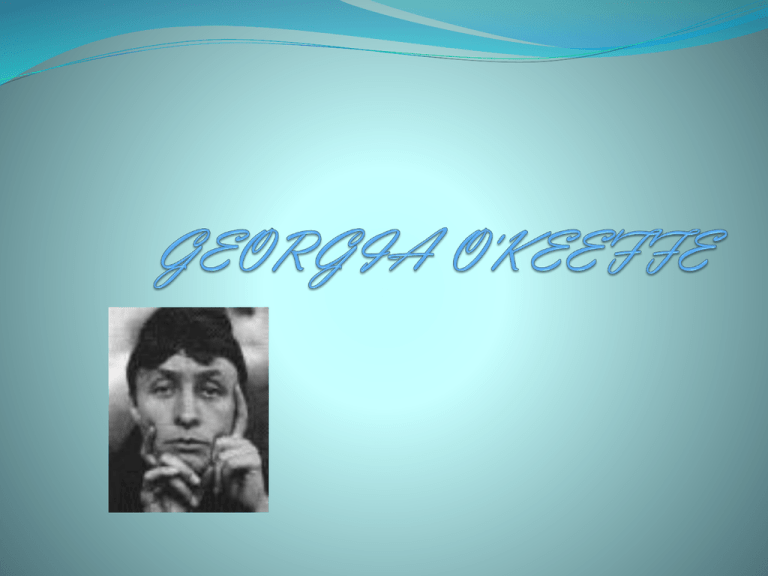
Early Life Born in Sun Prairie, Wisconsin November 15, 1887 Second of seven children Received art lessons at home Moved to Williamsburg Virginia at age 15 Early Years of Georgia O’Keeffe Studied at the Institute of Chicago (1905-1906) Studied at the Art Students league in New York (1907- 1908) Formed the art work - imitative realism Took a break from art for four years Taught art in 1915 What kinds of objects did O'Keeffe paint most often? O’Keeffe was drawn to natural objects such as shells, trees, animal bones, and flowers. Married Alfred Stieglitz Met Alfred Stieglitz in 1908 Exhibited 10 of her charcoal pictures in 1916 Married Alfred in 1924 Alfred was 23 years older than Georgia Another Picture Later Years Georgia went to New Mexico in 1929 Loved the scenery there Vacationed there every summer until Alfred died in 1946 Moved to New Mexico in 1949 Failing eyesight forced her to stop painting Lived there until her death 1986 In Red Poppy, how does the artist focus attention on the flower? O’Keeffe monumentalizes, or magnifies, the flower so that it is “larger than life.” She also crops the image so that it appears to be bursting out of the frame. Its intense, vibrant colors and visually interesting organic shapes take on a life of their own. When we study Red Poppy, it seems as though we are seeing this familiar flower for the first time. How did O'Keeffe create compositions using natural objects? One of her favorite techniques was to monumentalize flowers and other natural forms. She changed their scale, enlarging and cropping them until they filled a large canvas. Often, O’Keeffe would “zoom in” on a small, intricate part of a flower – such as its stamen – enlarging it until it was no longer recognizable. As O'Keeffe worked on her Jack-in-the-Pulpit series, how did the style of the paintings change? Although the first painting in the series was a realistic depiction of the jack-in-the-pulpit, O’Keeffe’s style became more abstract with each of the five subsequent paintings. In the last one, O’Keeffe enlarged and cropped the image so that only the “jack” remained. How has O'Keeffe used color in Jack-in-the-Pulpit IV? What kind of mood does the combination of colors create? The artist uses the natural colors of the flower, leaves, and sky. Closely related blues and greens are dark in value, capturing the flower’s mysterious quality. The deep purple of the flower itself becomes almost black in some areas, causing the bright focal point of the club-shaped “jack” to glow brightly in the center. The larger-than-life wild-flower takes on a primal quality suggesting new life emerging from the earth. What influence did the American Southwest have on O'Keeffe's art? O’Keeffe drew inspiration from the vivid colors, organic (curved) shapes, and bright light she found in the desert sky and rolling hills. She incorporate natural “found objects” such as desert flowers and sun-bleached animal bones into many of her paintings. O'Keeffe once said, "My paintings sometimes grow by pieces from what is around." How might this statement apply to Ram's Head with Hollyhock? O’Keeffe picked up the sunbleached skull during one of her walks in the nearby desert. Hollyhocks were among the flowers that grew in her vegetable garden. The composition of Ram’s Head with Holly hock “grew” from these natural objects, in which O’Keeffe found a quiet, mysterious beauty. In what kind of setting did the artist place Ram's Head with Holly hocks? O’Keeffe “floated” these objects over their natural desert habitat of hills and small, scrubby trees. Although the hills looked soft and rolling from a distance, they were difficult to negotiate. “I had looked out on the hills for weeks and painted them again and again,” said O’Keeffe. “I had climbed and ridden over them - so beautifully soft, so difficult when you get close up.” What kinds of colors has O'Keeffe used in this work? The colors are those of the desert sky and terrain: tans, grays, reddishbrowns, whites. Pale yellow in the center of the white flower adds a touch of subdued color in contrast to the bleak, gray clouds. What gives Ram's Head with Holly hock a mysterious, dreamlike quality? The monumentalized ram’s skull and white flower appear to float over the landscape below. They appear to be a timeless tribute to the desert that O’Keeffe loved. In Pelvis Series, Red and Yellow, is it immediately apparent that we are looking at an animal bone? Also, the subject as a bone. This work is completely abstract. The smooth, reddish-pink shapes are so stylized that only the title reveals the subject as a bone. What kind of geographical setting appealed to Georgia O'Keeffe? O’Keeffe was drawn to natural objects such as shells, trees, animal bones and flowers. Music Pink and Blue What was the inspiration for Sky Above Clouds? During a plane trip, O’Keeffe looked out the window and saw rows of small, oval clouds surrounded by “negative spaces” of blue sky. What are the principles that are constant in O'Keeffe's painting? 1. 2. 3. 4. 5. 6. 7. 8. 9. 10. 11. Emphasis on the land rather than sky A frontal viewpoint Horizontal bands of contrasting color Distortion of scale towards monumentality Flat even lighting and forms not hidden by shadows Exclusion of anything made by man A timeless quality Fragments of details of larger forms Elimination of details such as trees or erosion Intensity of colors Sculpture rounded sensual shapes. References Scholastic Art Magazine Www.O’Keeffemuseum.org www.webpages.marshall.edu www.theglassciling.com www.nmaa.si.education/kids/cappy/9/aokeeffebio.html www.Sheldon.unl.edu/HTML/ARTIST?O”Keeffe_g/ssi .html References (continued) Www.wysiwyg://main.o’feeffe.org/visit/exhibitions/ok eeffes.html www.georgiaglobe.org O’KEEFFE by Britta Benke Watch Video Late Career of Georgia O’Keeffe Discover Education Streaming
